You are using an out of date browser. It may not display this or other websites correctly.
You should upgrade or use an alternative browser.
You should upgrade or use an alternative browser.
GoldPlanar GL-AMT16
- Added by johnchpark
- Create date
Eddie Knows
New Head-Fier
Pros: Rich, detailed sound
Good soundstage
Good soundstage
Cons: Lacking sub bass
Can sound soft
Can sound soft
About me
This is my first time giving impressions on an iem. I've owned and listened to quite a few iems in the past 10 years but perhaps my critical listening isn't up to par with people who review often. The most recent iems I've owned are the 64 Audio U12t, Campfire Andromeda and the Raptgo Hook. I'll compare primarily to the U12t because I currently still have it in my possession.
Source
Unfortunately my only player is an Asus Rog Phone 5. It has a higher end Ess Saber dac but it's still not a dedicated audio player. It's able to power the Goldplanars but I have to play my music at 80 - 100% volume whereas I listen to the U12t between 60 - 80%. There's no way to bypass the DSP on this phone. I keep it on the most neutral setting. Apologies for the subpar conditions. Please keep this in mind whilst reading.
Quick notes on build quality
The metal shell feels very solid - even more so than the U12t or Campfire Andromeda. Marketing advertises this as aircraft grade aluminium and I can believe it. I've no idea how fragile the Amt drivers themselves are and I hope I don't have to find out. Cable is solid - perhaps a bit thick for my tastes but it's high quality.
What's Special
Before I get into the details I have to point out what makes these iems special - the amt drivers have an amazing analogue quality. They can trick my brain into thinking that I'm listening to an actual instrument or voice better than any iem I've tried. The U12t might reproduce music excellently but it feels like the GoldPlanar Amt16 removes a barrier between myself and the music. Percussion especially can sound close to the real deal. The emotion present in singing hits harder because it sounds like it's physically emitting from somewhere.
Don't get me wrong I'm not saying it sounds like reality. The amt driver can sound soft at times. Still, because it has that analogue quality I feel more connected to my music.
Bass
This set doesn't have much sub bass rumble. The bass is nicely textured so I wouldn't call it thin. It's like someone took a DD driver then cut down its sub frequencies. Comparing to my U12ts - the U12ts have more sub bass while the Goldplanars have better upper bass detail. I think I prefer the U12ts bass but the Goldplanars bass is nicely cohesive with the rest of its sound signature. This set comes with different nozzles which can alter the sound signature though none seem to boost the sub bass very much. I don't usually EQ but I tried out of curiosity - it's possible to add some rumble back in but you won't be tricked into thinking that this is a bassy set. I don't like messing with tuning so I'm going back to flat. Overall I'm satisfied with the bass but I can see bassheads being disappointed.
Mids
The mids are the best thing about this set and the hardest to write about. I have no complaints. I quite like that the mids have a forward presentation, placing most instruments and vocals close to me. I like how the decay naturally fades off into the distance, giving a sense of space. I think the slight softness of the Amt sound helps here - the mids are very present without being too much.
Treble
I went hunting for a new iem after owning the U12t for two years because its treble kept hurting me; I finally threw in the towel. I really like the U12t but I can't deal with it any more. It's strange because I've seen other people describe it as non-fatiguing. I might just be particularly sensitive to its treble peak. No such issues with the goldplanar. The treble is still nicely extended. According to graphs it trails off right where the U12t spikes upwards. This is pretty much ideal for me but perhaps others might miss some sparkle? No idea. I don't find much pleasant in that region. The Campfire Andromeda sparkle could be fun but even then I wasn't completely enamoured.
Technicalities
To compare - The U12ts are impressive and detail-oriented but the music feels a bit far from me. I'm a couple of rows back from the stage. I'm thinking about how great the sound is rather than feeling. With the Goldplanars, I'm in the studio. I have a clear picture of where the studio mics are placed. In Doris Days rendition of 'Dream a little dream of me' I can hear the piano plucking away below me whilst Doris is singing to the mid/top right. It feels like I'm a studio exec standing in the room as they're recording. I don't think I'd call the sound stage intimate. Rather, the sound stage extends out into a spacious room but because the mids are prominent it sounds like the instruments are relatively close to me within this big room. Sense of space is impressive for an iem. The U12t wins in depth whilst the Goldplanars win in both width and height. U12t edges the Goldplanars out in separating micro details - maybe because of the speed of ba drivers. Both are TOTL in terms of resolution and dynamics. Speaking of Doris Day these iems are amazing on well recorded vintage tracks. Modern music sounds great as well but real instruments recorded on vintage equipment are a treat. I've shifted my music listening habits recently because of these.
Ending thoughts
Are the Goldplanars perfect? No. I would add a bit of sub bass, a bit more stage depth, remove a touch of softness. That said? This is the first time I'm asking if I own the perfect iem after about a decade of enjoying this hobby. These are something special.
This is my first time giving impressions on an iem. I've owned and listened to quite a few iems in the past 10 years but perhaps my critical listening isn't up to par with people who review often. The most recent iems I've owned are the 64 Audio U12t, Campfire Andromeda and the Raptgo Hook. I'll compare primarily to the U12t because I currently still have it in my possession.
Source
Unfortunately my only player is an Asus Rog Phone 5. It has a higher end Ess Saber dac but it's still not a dedicated audio player. It's able to power the Goldplanars but I have to play my music at 80 - 100% volume whereas I listen to the U12t between 60 - 80%. There's no way to bypass the DSP on this phone. I keep it on the most neutral setting. Apologies for the subpar conditions. Please keep this in mind whilst reading.
Quick notes on build quality
The metal shell feels very solid - even more so than the U12t or Campfire Andromeda. Marketing advertises this as aircraft grade aluminium and I can believe it. I've no idea how fragile the Amt drivers themselves are and I hope I don't have to find out. Cable is solid - perhaps a bit thick for my tastes but it's high quality.
What's Special
Before I get into the details I have to point out what makes these iems special - the amt drivers have an amazing analogue quality. They can trick my brain into thinking that I'm listening to an actual instrument or voice better than any iem I've tried. The U12t might reproduce music excellently but it feels like the GoldPlanar Amt16 removes a barrier between myself and the music. Percussion especially can sound close to the real deal. The emotion present in singing hits harder because it sounds like it's physically emitting from somewhere.
Don't get me wrong I'm not saying it sounds like reality. The amt driver can sound soft at times. Still, because it has that analogue quality I feel more connected to my music.
Bass
This set doesn't have much sub bass rumble. The bass is nicely textured so I wouldn't call it thin. It's like someone took a DD driver then cut down its sub frequencies. Comparing to my U12ts - the U12ts have more sub bass while the Goldplanars have better upper bass detail. I think I prefer the U12ts bass but the Goldplanars bass is nicely cohesive with the rest of its sound signature. This set comes with different nozzles which can alter the sound signature though none seem to boost the sub bass very much. I don't usually EQ but I tried out of curiosity - it's possible to add some rumble back in but you won't be tricked into thinking that this is a bassy set. I don't like messing with tuning so I'm going back to flat. Overall I'm satisfied with the bass but I can see bassheads being disappointed.
Mids
The mids are the best thing about this set and the hardest to write about. I have no complaints. I quite like that the mids have a forward presentation, placing most instruments and vocals close to me. I like how the decay naturally fades off into the distance, giving a sense of space. I think the slight softness of the Amt sound helps here - the mids are very present without being too much.
Treble
I went hunting for a new iem after owning the U12t for two years because its treble kept hurting me; I finally threw in the towel. I really like the U12t but I can't deal with it any more. It's strange because I've seen other people describe it as non-fatiguing. I might just be particularly sensitive to its treble peak. No such issues with the goldplanar. The treble is still nicely extended. According to graphs it trails off right where the U12t spikes upwards. This is pretty much ideal for me but perhaps others might miss some sparkle? No idea. I don't find much pleasant in that region. The Campfire Andromeda sparkle could be fun but even then I wasn't completely enamoured.
Technicalities
To compare - The U12ts are impressive and detail-oriented but the music feels a bit far from me. I'm a couple of rows back from the stage. I'm thinking about how great the sound is rather than feeling. With the Goldplanars, I'm in the studio. I have a clear picture of where the studio mics are placed. In Doris Days rendition of 'Dream a little dream of me' I can hear the piano plucking away below me whilst Doris is singing to the mid/top right. It feels like I'm a studio exec standing in the room as they're recording. I don't think I'd call the sound stage intimate. Rather, the sound stage extends out into a spacious room but because the mids are prominent it sounds like the instruments are relatively close to me within this big room. Sense of space is impressive for an iem. The U12t wins in depth whilst the Goldplanars win in both width and height. U12t edges the Goldplanars out in separating micro details - maybe because of the speed of ba drivers. Both are TOTL in terms of resolution and dynamics. Speaking of Doris Day these iems are amazing on well recorded vintage tracks. Modern music sounds great as well but real instruments recorded on vintage equipment are a treat. I've shifted my music listening habits recently because of these.
Ending thoughts
Are the Goldplanars perfect? No. I would add a bit of sub bass, a bit more stage depth, remove a touch of softness. That said? This is the first time I'm asking if I own the perfect iem after about a decade of enjoying this hobby. These are something special.
Last edited:
johnchpark
Head-Fier
Pros: Great analog-like texture that is unique from traditional BA, DD, or EST driver IEMs
Great resolution
Good tuning
Great imaging
Great resolution
Good tuning
Great imaging
Cons: 2kHz pinna is a bit peaky and makes sounds too forward
Note attack speeds are slower than BA drivers, but this attributes to its analog-like texture
Cable feels plastic-y and stiff
Note attack speeds are slower than BA drivers, but this attributes to its analog-like texture
Cable feels plastic-y and stiff
Disclaimer: I am an IEM engineer and am heavily involved in the industry. I have been involved in the tuning and engineering of numerous IEM’s from numerous different popular IEM brands. I did not purchase the GL-AMT16, and tested it as a distributor sample from the factory. I do not profit from any GoldPlanar sales.
I go through A LOT of IEMs every year, but I am hardly ever bothered to write a review.
Furthermore, I considered most of GoldPlanar's previous headphones to be flops.
However, the GoldPlanar GL-AMT16 ("AMT16" from here on out) was surprisingly pleasant enough to be deemed worth a review.
Packaging:
Put simply, this is one of the most extravagant unboxing experiences I have ever had, period. I have never seen an IEM packaging be this nice from any brand. Inside the cardboard box is a solid, genuine wooden case with a sliding lid. The insides are layered with velvet packing. As someone involved in the industry, I was jealous my own brands couldn't match this level of product presentation. The Pelican case is also a huge plus.
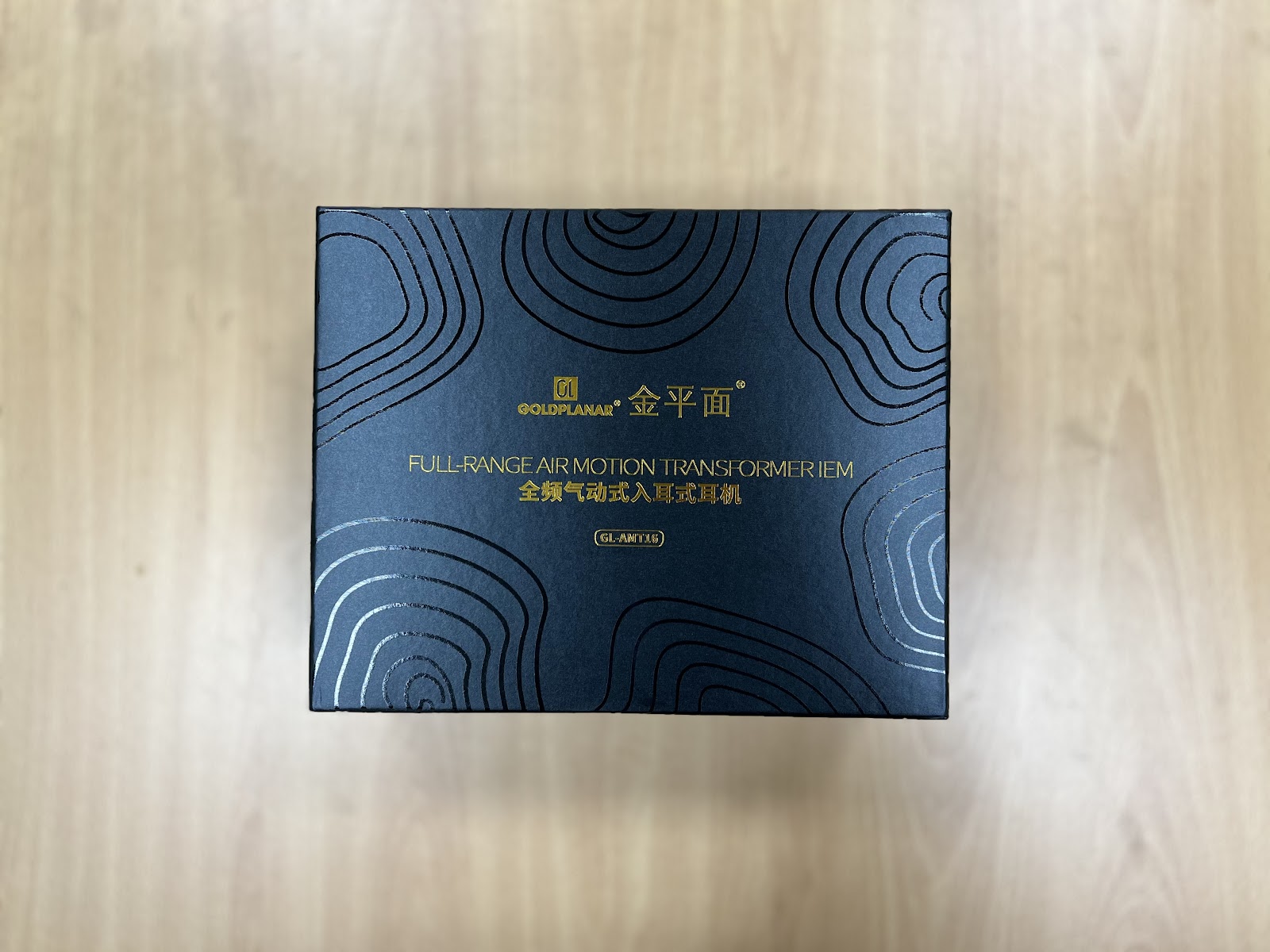

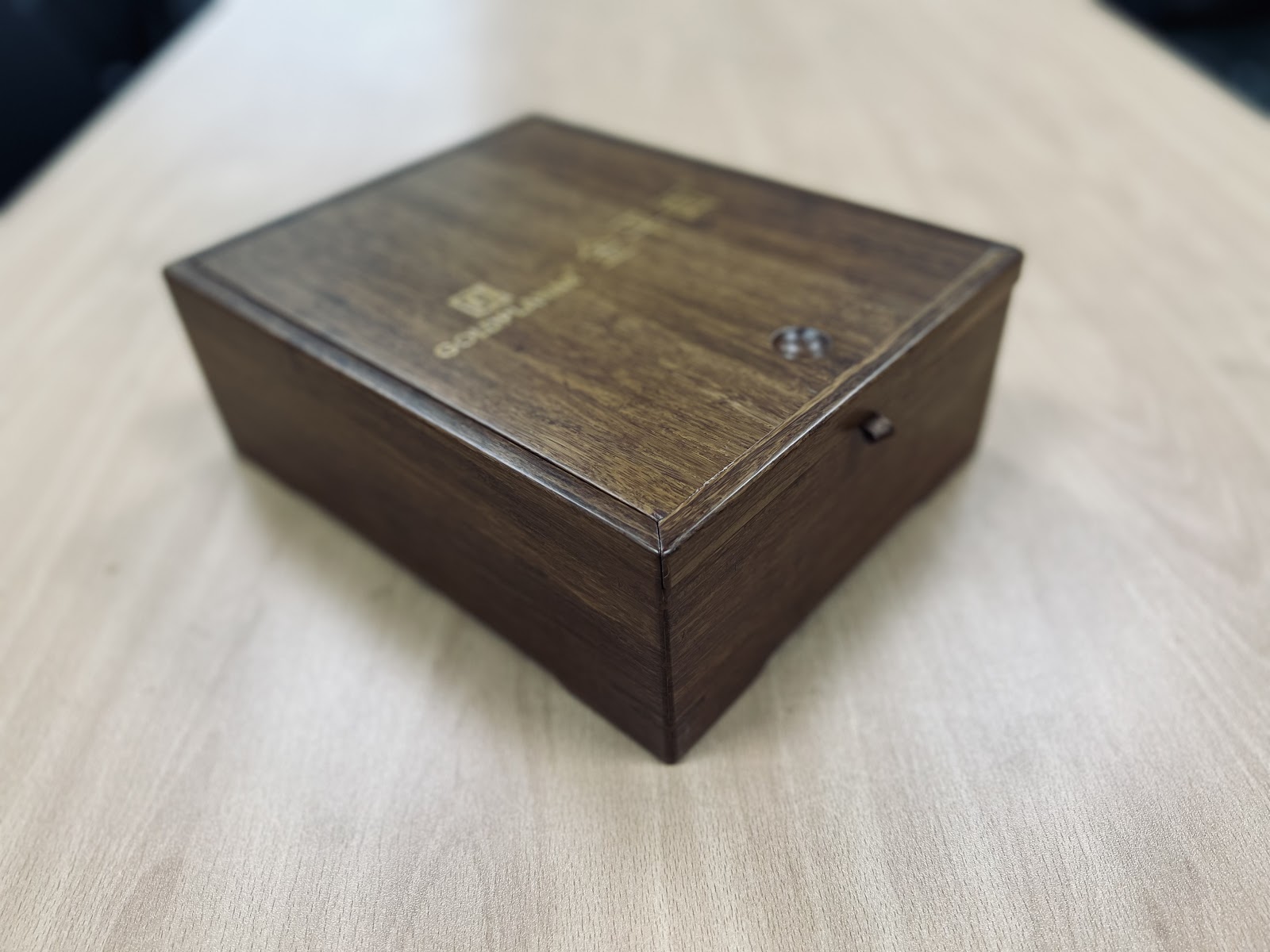
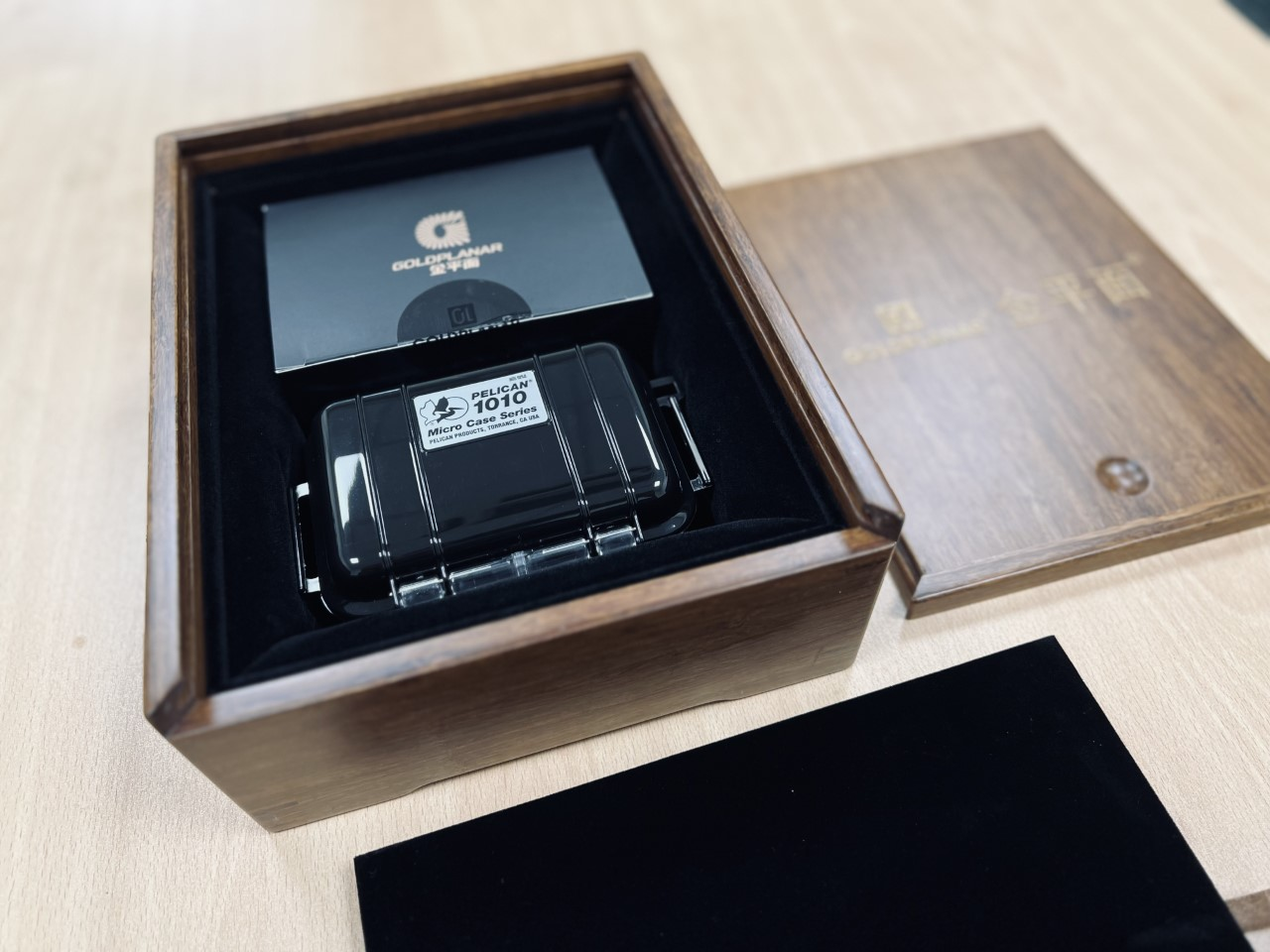
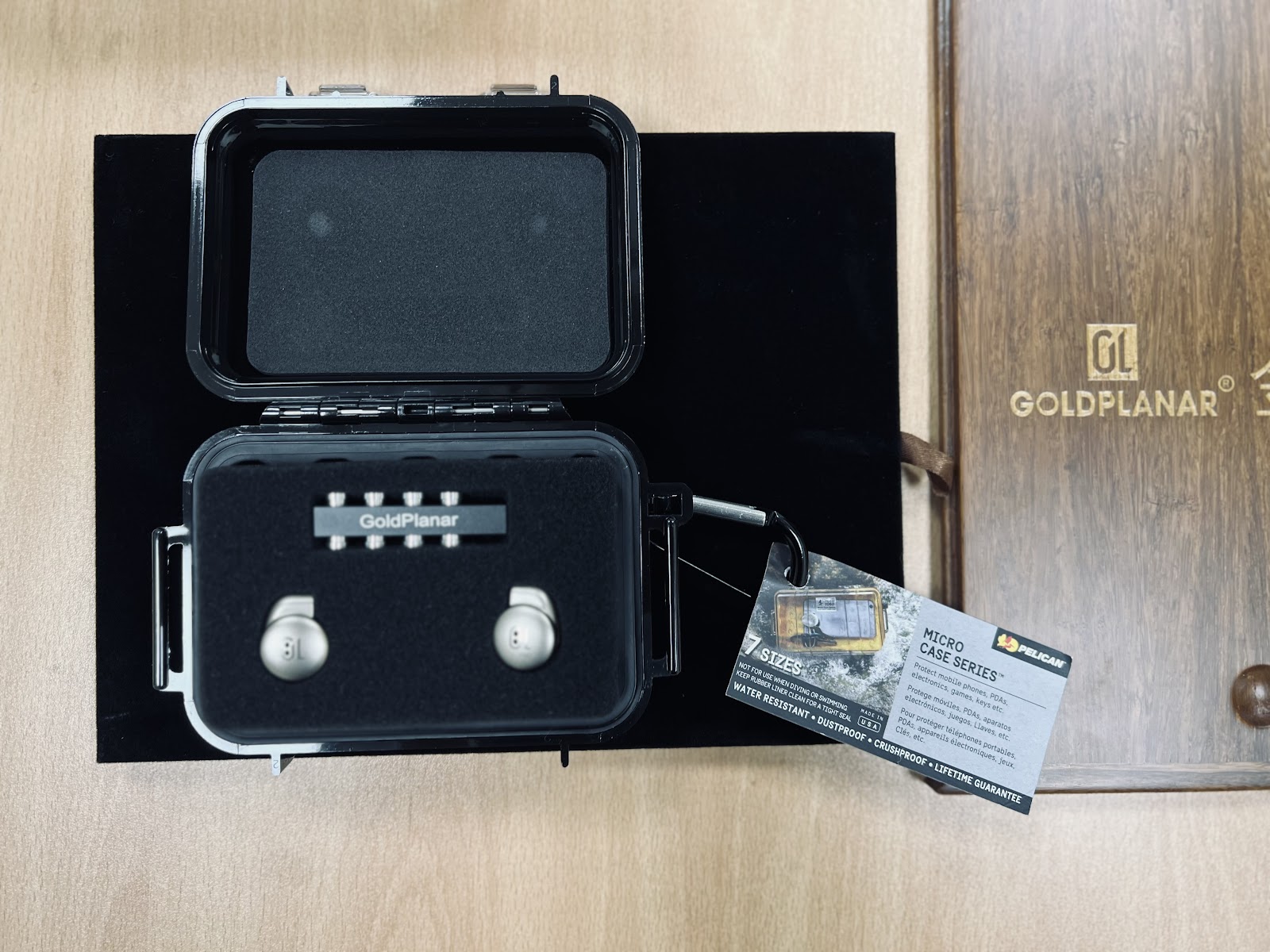
Cable:
The cable is one of those modular cable, similar to the Dunu or Thieaudio cables, with 3.5mm, 2.5mm, and 4.4mm connectors. The cable is an 8-core with 6 strands of copper and 2 strands of gold plated copper cables. My only gripe is that the cable feels a bit plastic-y and stiff, especially the ear hook.
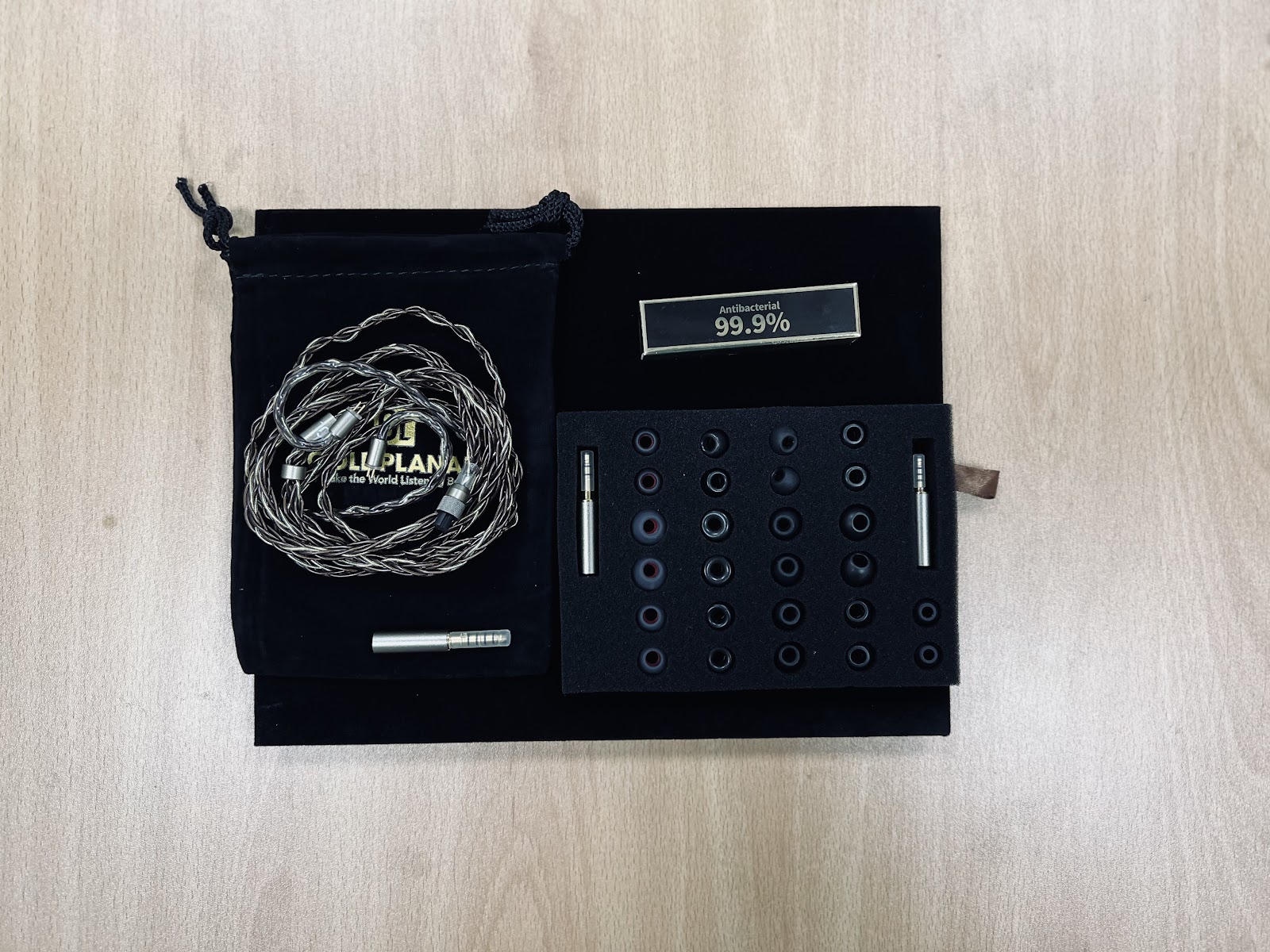
Fit:
The AMT16 isn’t too big and fits perfectly in my ears. It’s relatively slim so it doesn’t stick out obnoxiously either. It’s a really comfortable and slick fit and look.
Nozzles:
The AMT16 comes with five different nozzles. As an IEM engineer, I was really excited to see what they did with their nozzles. Normally, IEMs with exchangeable screw-on nozzles change the sound using different types of dampening filters. However, the AMT16 nozzles don’t have any dampening filters. Instead, they change the treble frequency by adjusting the nozzle diameters. Nozzle diameter on frequency changes is a fundamental component of IEM tuning, but you hardly ever see it utilized as an active way for users to adjust the tuning. It’s incredibly clever, and effective, as you can see by the frequency measurements.
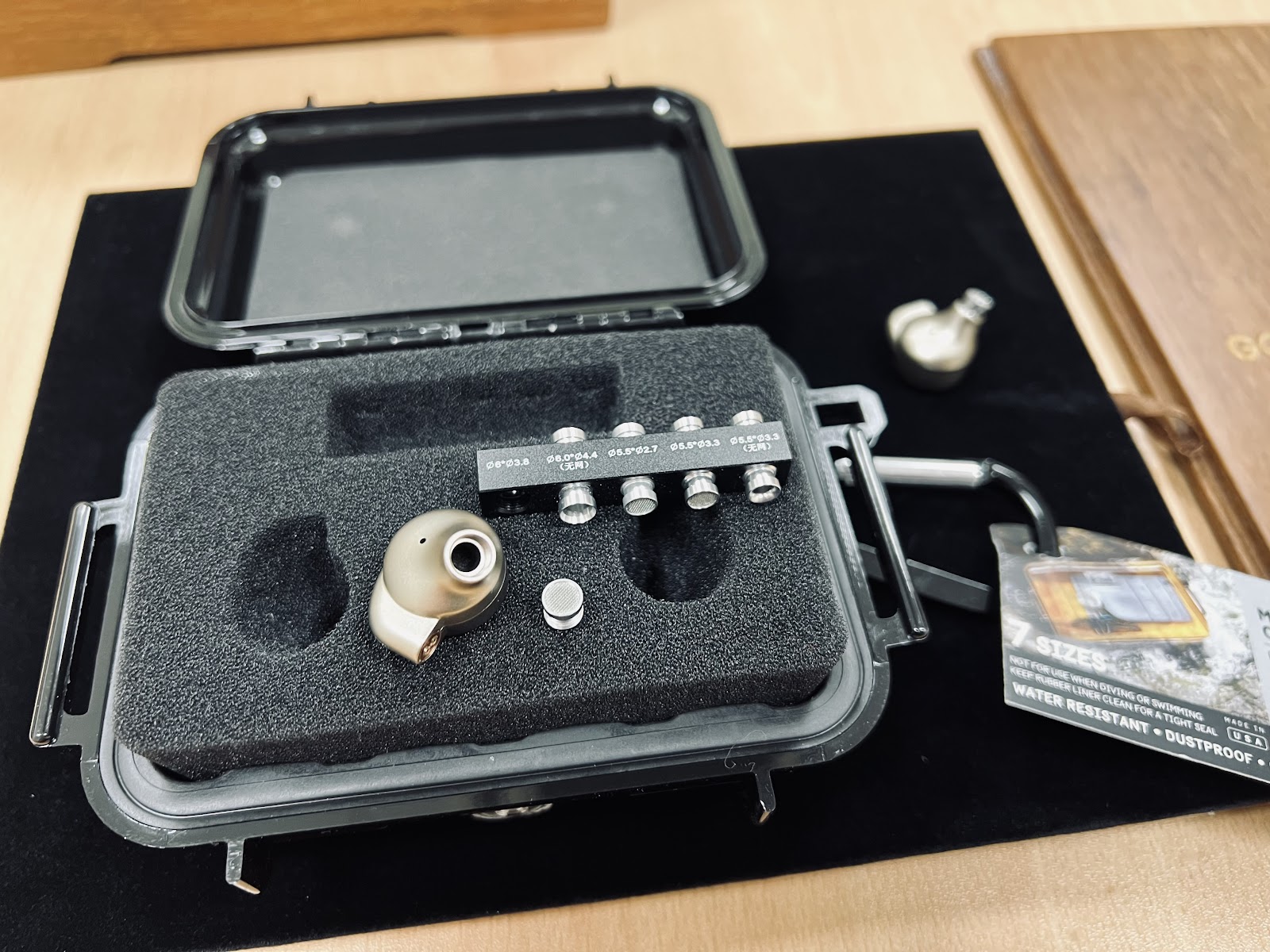

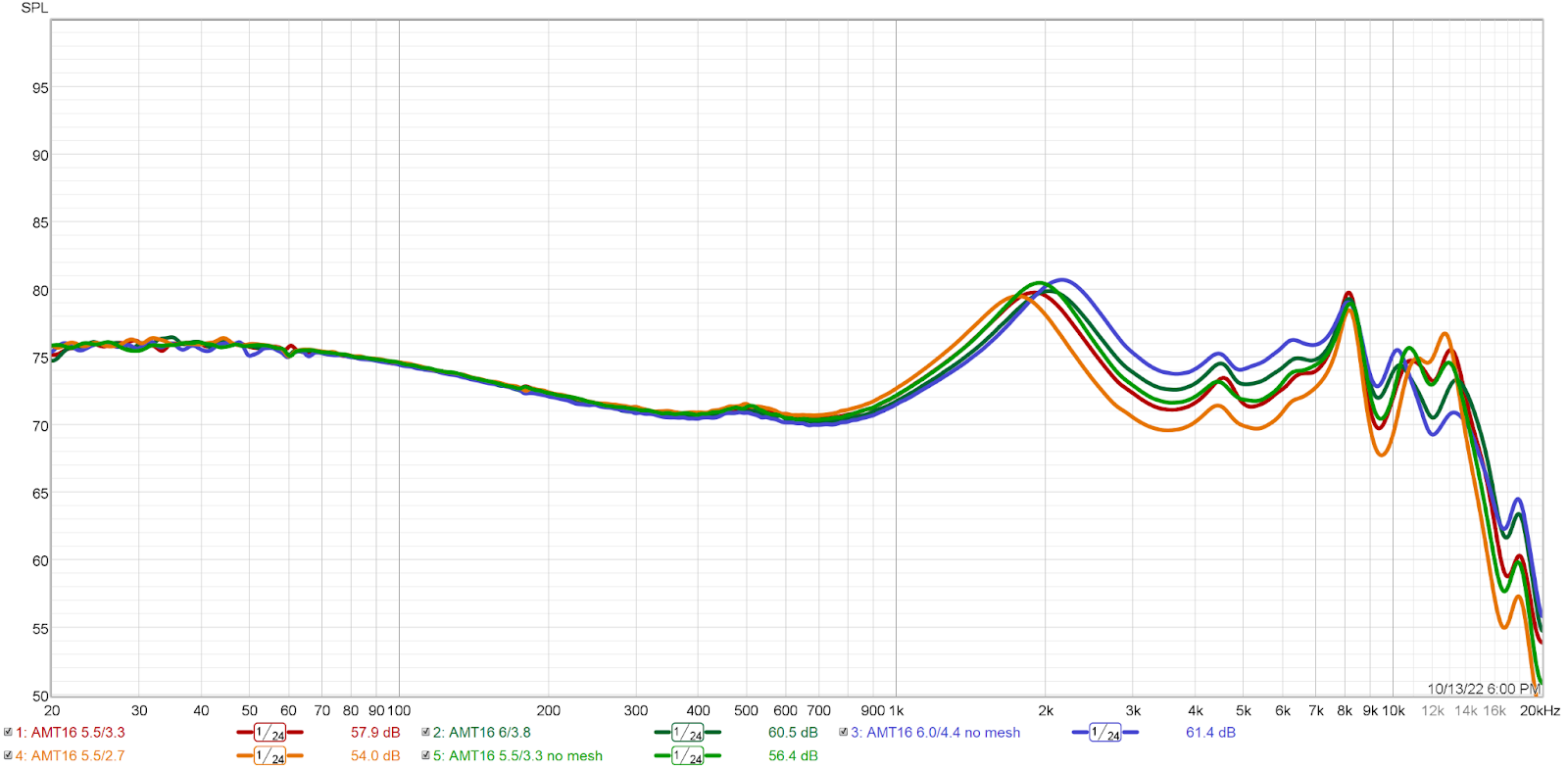
In short, the nozzle diameters (indicated on the nozzle holder) change the 1kHz ~ 15kHz range up to 5dB. It’s not a gimmick, and this is classical knowledge utilized innovatively. A huge applause to the GoldPlanar team.
Sound:
As an IEM engineer, I believe the IEM industry is at a stagnant point, mostly due to the lack of new driver types. From a technicalities point of view, there is only so much you can do with typical BA, DD, or even EST drivers to make them really stand out. Most of the successful “traditional” IEMs lately were great mostly due to their tuning strategies rather than their technicalities compared to what's already out there. However, the AMT driver that the AM16 utilizes may be a fresh revitalization for the IEM industry.
I usually will tear apart such IEMs I receive to see the drivers, but I like the AMT16 so much that I will keep it intact. But what I can tell is that it seems to be the real deal and not a gimmick. The sound definitely has an analog-like quality, reminiscent of ribbon transducers. The texture sounds very relaxed, as if the driver is putting out sound with ease. Directly compared to an all BA IEM such as the Thieaudio V16, the BA drivers sound plastic-y and strained while the AMT drivers sound much more relaxed. In fact, this is probably because the BA drivers have faster transients and attacks compared to the AMT. Notes on typical BA or Tribrid IEMs end up sounding tighter while the AMT16 feels more laidback. For this reason, it's a little hard to directly compare perceived resolution. While the AMT16 definitely has great texture and smoothness, the attacks definitely feel blunted compared to the transients of BA drivers, which makes the AMT16 feel hazy in the notes. But overall, I would say it's as resolving as any of my other TOPL IEMs, albeit the differences in attack and decay speeds.
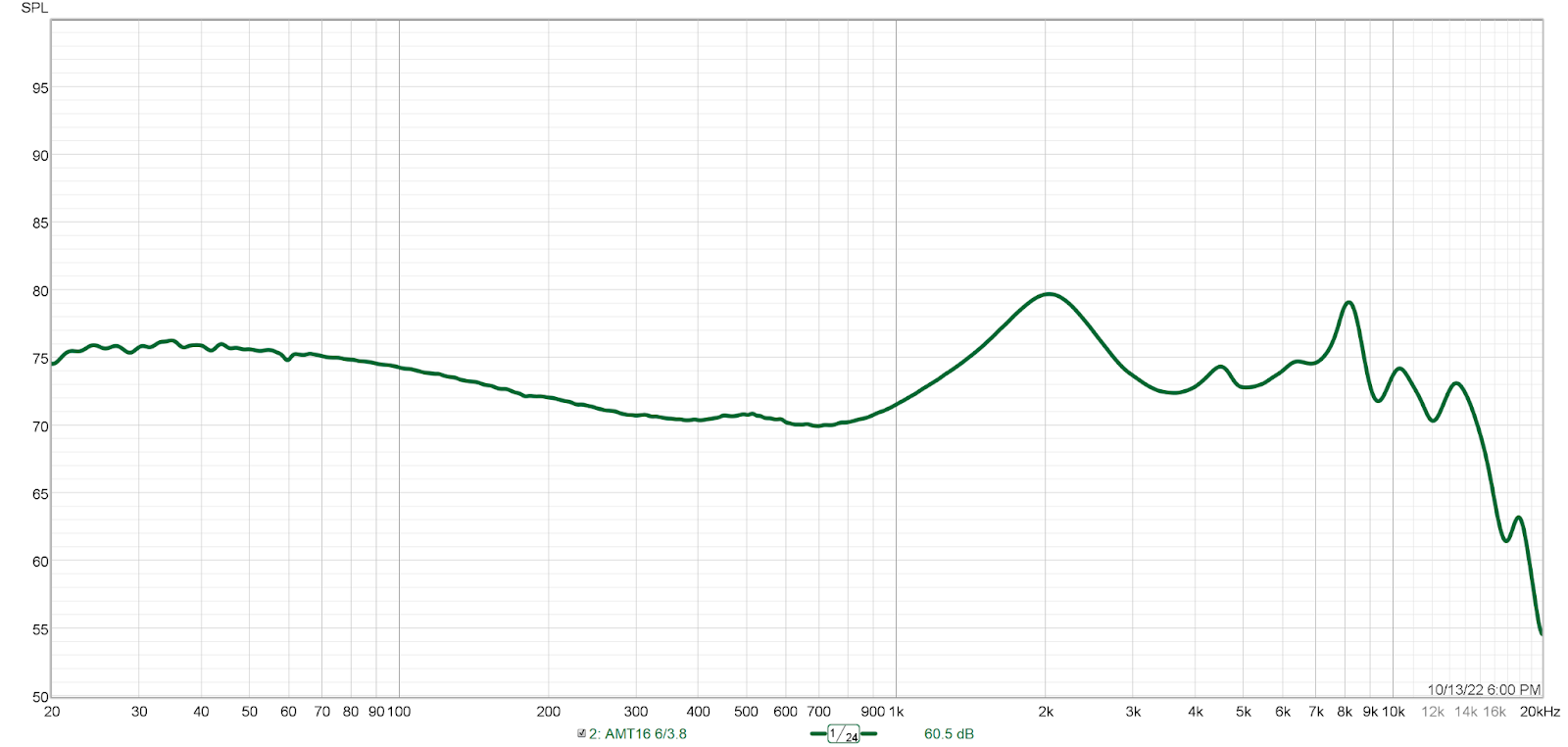
The tuning is surprisingly good for a new driver type (I was half expecting it to be a complete tuning mess). I don’t have any significant complaints about the tuning except that it does have a very sharp 2kHz pinna peak, which is audible. It makes a lot of instruments and voices very forward and slightly honky. Putting a black dampening filter sticker (like those found on Moondrop or Tanchjim products) does reduce this pinna, but also does so too much. The bass doesn’t slam, which is also evident by the frequency graph, but it is quite punchy and well balanced. I would say the mids on the AMT16 are its highlight, which are very rich and lush, and have a great analog quality to them. The good treble extension also provides a nice airiness to the overall sound and helps with the resolution. Imaging and depth is excellent with most tracks. Jazz was simply a delight to listen to with these. Brushes on drums never sounded so good.

(AMT16 with a Tanchjim Dampening Filter on the nozzle)
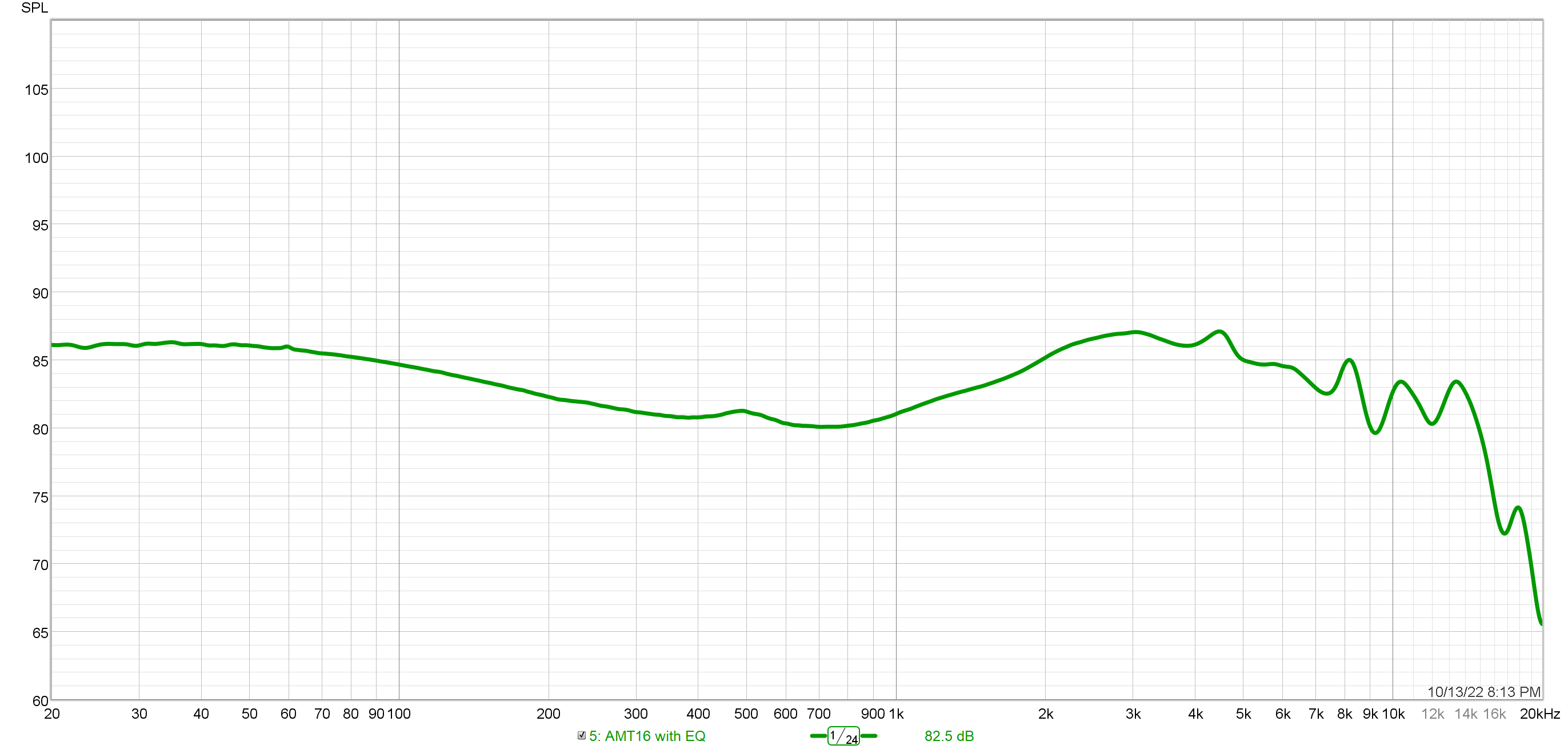
(AMT16 with EQ; light adjustments at 2kHz, 3.1kHz, 5kHz, and 8kHz)
Overall, the tuning of the AMT16 is acceptable, but not perfect to my ears. It does need some physical adjustments or EQ to reduce the 2kHz pinna. But apart from that, the AMT driver utilized definitely gives a unique textural quality that is refreshingly new in the IEM industry. It’s truly an analog-like sound that stands out from the typical BA, EST, or even planar timbre. Rather than simply "the best single IEM out there", I believe the AMT16 stands out as a technological innovation that is worth its place in a collection. Because of its textural characteristics, it's not suitable for stage or studio use (plus, I don't think it will handle drops well due to the driver). Instead, the AMT16 is perfect for audio enthusiasts who have other IEMs and want a product that is strictly unique and refreshing. I’m sure in the coming future, we will see more of these AMT drivers used by other manufacturers (like what happened with IEM planar drivers), and I’m really excited to see if this will turn into a new era for the IEM industry.
I go through A LOT of IEMs every year, but I am hardly ever bothered to write a review.
Furthermore, I considered most of GoldPlanar's previous headphones to be flops.
However, the GoldPlanar GL-AMT16 ("AMT16" from here on out) was surprisingly pleasant enough to be deemed worth a review.
Packaging:
Put simply, this is one of the most extravagant unboxing experiences I have ever had, period. I have never seen an IEM packaging be this nice from any brand. Inside the cardboard box is a solid, genuine wooden case with a sliding lid. The insides are layered with velvet packing. As someone involved in the industry, I was jealous my own brands couldn't match this level of product presentation. The Pelican case is also a huge plus.

Cable:
The cable is one of those modular cable, similar to the Dunu or Thieaudio cables, with 3.5mm, 2.5mm, and 4.4mm connectors. The cable is an 8-core with 6 strands of copper and 2 strands of gold plated copper cables. My only gripe is that the cable feels a bit plastic-y and stiff, especially the ear hook.
Fit:
The AMT16 isn’t too big and fits perfectly in my ears. It’s relatively slim so it doesn’t stick out obnoxiously either. It’s a really comfortable and slick fit and look.
Nozzles:
The AMT16 comes with five different nozzles. As an IEM engineer, I was really excited to see what they did with their nozzles. Normally, IEMs with exchangeable screw-on nozzles change the sound using different types of dampening filters. However, the AMT16 nozzles don’t have any dampening filters. Instead, they change the treble frequency by adjusting the nozzle diameters. Nozzle diameter on frequency changes is a fundamental component of IEM tuning, but you hardly ever see it utilized as an active way for users to adjust the tuning. It’s incredibly clever, and effective, as you can see by the frequency measurements.
In short, the nozzle diameters (indicated on the nozzle holder) change the 1kHz ~ 15kHz range up to 5dB. It’s not a gimmick, and this is classical knowledge utilized innovatively. A huge applause to the GoldPlanar team.
Sound:
As an IEM engineer, I believe the IEM industry is at a stagnant point, mostly due to the lack of new driver types. From a technicalities point of view, there is only so much you can do with typical BA, DD, or even EST drivers to make them really stand out. Most of the successful “traditional” IEMs lately were great mostly due to their tuning strategies rather than their technicalities compared to what's already out there. However, the AMT driver that the AM16 utilizes may be a fresh revitalization for the IEM industry.
I usually will tear apart such IEMs I receive to see the drivers, but I like the AMT16 so much that I will keep it intact. But what I can tell is that it seems to be the real deal and not a gimmick. The sound definitely has an analog-like quality, reminiscent of ribbon transducers. The texture sounds very relaxed, as if the driver is putting out sound with ease. Directly compared to an all BA IEM such as the Thieaudio V16, the BA drivers sound plastic-y and strained while the AMT drivers sound much more relaxed. In fact, this is probably because the BA drivers have faster transients and attacks compared to the AMT. Notes on typical BA or Tribrid IEMs end up sounding tighter while the AMT16 feels more laidback. For this reason, it's a little hard to directly compare perceived resolution. While the AMT16 definitely has great texture and smoothness, the attacks definitely feel blunted compared to the transients of BA drivers, which makes the AMT16 feel hazy in the notes. But overall, I would say it's as resolving as any of my other TOPL IEMs, albeit the differences in attack and decay speeds.
The tuning is surprisingly good for a new driver type (I was half expecting it to be a complete tuning mess). I don’t have any significant complaints about the tuning except that it does have a very sharp 2kHz pinna peak, which is audible. It makes a lot of instruments and voices very forward and slightly honky. Putting a black dampening filter sticker (like those found on Moondrop or Tanchjim products) does reduce this pinna, but also does so too much. The bass doesn’t slam, which is also evident by the frequency graph, but it is quite punchy and well balanced. I would say the mids on the AMT16 are its highlight, which are very rich and lush, and have a great analog quality to them. The good treble extension also provides a nice airiness to the overall sound and helps with the resolution. Imaging and depth is excellent with most tracks. Jazz was simply a delight to listen to with these. Brushes on drums never sounded so good.

(AMT16 with a Tanchjim Dampening Filter on the nozzle)

(AMT16 with EQ; light adjustments at 2kHz, 3.1kHz, 5kHz, and 8kHz)
Overall, the tuning of the AMT16 is acceptable, but not perfect to my ears. It does need some physical adjustments or EQ to reduce the 2kHz pinna. But apart from that, the AMT driver utilized definitely gives a unique textural quality that is refreshingly new in the IEM industry. It’s truly an analog-like sound that stands out from the typical BA, EST, or even planar timbre. Rather than simply "the best single IEM out there", I believe the AMT16 stands out as a technological innovation that is worth its place in a collection. Because of its textural characteristics, it's not suitable for stage or studio use (plus, I don't think it will handle drops well due to the driver). Instead, the AMT16 is perfect for audio enthusiasts who have other IEMs and want a product that is strictly unique and refreshing. I’m sure in the coming future, we will see more of these AMT drivers used by other manufacturers (like what happened with IEM planar drivers), and I’m really excited to see if this will turn into a new era for the IEM industry.
Last edited:
o0genesis0o
Very nice to read a review from someone with engineering knowledge about IEM!
Bitsir
Can't wait for AMT & MEMs to ravage the IEM scene in the coming years. The diamond age of IEMs is yet to come.
Steranko
I got a pair of these today via recommendation from other people as well and boy are these good for the price. Don't use the stock cables and they are very impressive. Highly recommended to try out. You literally getting equivalent of uninhibited Obravo CU sound for a quarter of the price.
ToneDeafMonk
Previously known as TheDeafMonk
Pros: What I Liked:
Very Analogue presentation through all of the entire frequency spectrum
Not like anything else currently on the market
Unboxing Experience second to NONE
Build quality and fitment should work for most people.
AMT uniqueness translates into a wide open stage
Natural way of replaying the music without effort and distortion
Very Analogue presentation through all of the entire frequency spectrum
Not like anything else currently on the market
Unboxing Experience second to NONE
Build quality and fitment should work for most people.
AMT uniqueness translates into a wide open stage
Natural way of replaying the music without effort and distortion
Cons: What I Though Needed Improvement: (Subjective)
NOWHERE IN THE LITERATURE DOES IT EXPLAIN WHAT SOUND EFFECTS THE DIFFERENT TUNING NOZZLES DO TO THE TUNING. TRIAL AND ERROR AND NOT ACCEPTABLE.
Mid Bass attack may not be for some as it was done in a way to be present to enhance rather than be fully present in the mix
Packaging was overly done to my tastes and I found a bit excessive even on a set costing $1499 Packaging clocks in at 3.2KG over TEN pounds!
The 2KHz peak in all tuning adds too much of a forwardness and resonances that needs to be addressed a little bit with a tuning filter in order to bring it down to a more natural level in my opinion.
NOWHERE IN THE LITERATURE DOES IT EXPLAIN WHAT SOUND EFFECTS THE DIFFERENT TUNING NOZZLES DO TO THE TUNING. TRIAL AND ERROR AND NOT ACCEPTABLE.
Mid Bass attack may not be for some as it was done in a way to be present to enhance rather than be fully present in the mix
Packaging was overly done to my tastes and I found a bit excessive even on a set costing $1499 Packaging clocks in at 3.2KG over TEN pounds!
The 2KHz peak in all tuning adds too much of a forwardness and resonances that needs to be addressed a little bit with a tuning filter in order to bring it down to a more natural level in my opinion.
My Goldplanar GL-AMT16 Review is here for those who like to read.

Title1200×628 128 KB
GOLDPLANAR GL-AMT16 AUG 21 2023

Screenshot 2023-08-19 at 11-11-21 2741.84C$ Goldplanar Gl-amt16 Full-range Pneumatic In-ear Headphones N52 Neodymium Magnetic High End Hifi Headphones - Home Theater Amplifiers - AliExpress509×509 242 KB
This one was so graciously loaned from a fellow audiophile code name Dennis and my many thanks for the opportunity to listen to these unique IEM’S
THIS IS A NEW USE OF A 40YR OLD DREAM
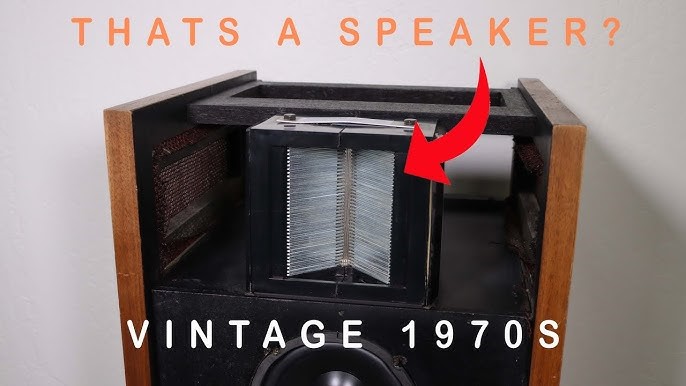
The Goldplanar GL-AMT16 is a single driver IEM utilizing a 15.5mm Air Motion Transformer
This technology was invented by Dr. Oskar Heil in the 70’s
Now let’s get into it: The Techy Stuff
I am going to be spending a bit of time explaining what a AMT is:
An AMT is a form of electrostatic driver a dipole meaning sound is produced on both sides of the driver.
Essentially there is the diaphragm membrane up front there are powerful magnets in the back and there’s a dampening material in the centre to absorb all the unwanted rear waves.
Where a conventional dynamic driver has a voice coil that pushes the cone around the edge, a AMT has its motor bonded onto its surface.
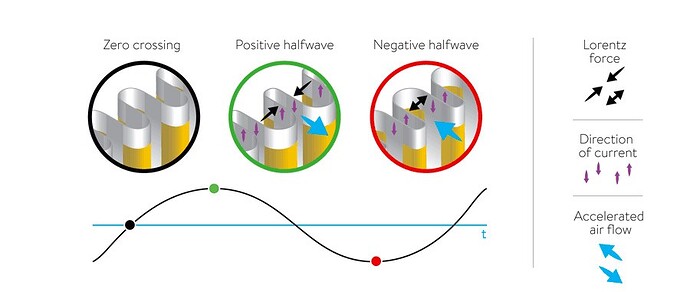
How it works900×381 42.9 KB
The AMT diaphragm is made up of a layer of Kapton - a type of polyimide film and a layer of aluminum bonded to it for the electrical signal to be passed through it.
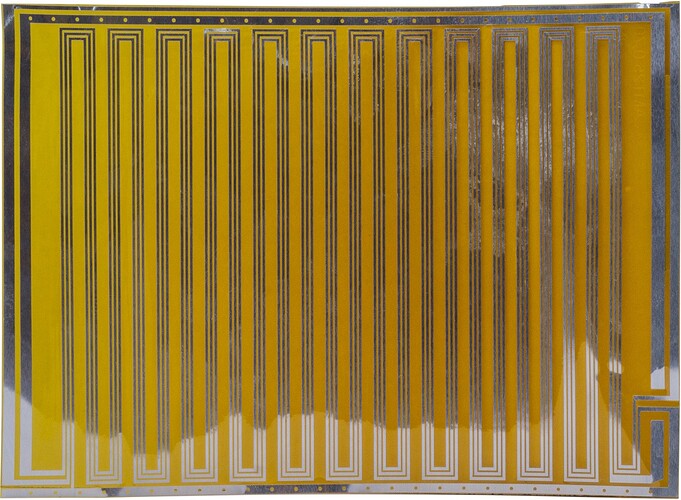
Substrait1500×1100 457 KB
The Diaphragm is actually, folded in a way with gaps between the folds.
When signal is passed along the circuit in opposing directions it causes the diaphragm to compress and expand the fold causing the air to be squeezed in and out like a bellow.

Folded Motion1297×418 119 KB
There is a lot of surface area in such a small space and to give you a idea how much this 15.5mm diaphragm is squeezed in there the equivalent surface area in a dynamic driver would be 120mm or roughly 8 times a conventional driver.
Now this is not new technology per say but because of the ultra linear response and quick speed Air Motion Transducers were used primarily in tweeters or upper midrange drivers in combination with conventional dynamic drivers for years in higher end speakers and monitors. The primary reason you didn’t see the tech everywhere in the past was higher cost to manufacture.
In 2020 a company called HEDDphone EX Adam Audio guys started using a full range AMT in their headphones. It has a frequency range of an outstanding 10hz-40khz! Admittingly, they knew the whole headphones were heavy and needed power as well. BUT THE SOUND.

AS_HEDD_heddphoneone_02_1024x10241000×1000 134 KB
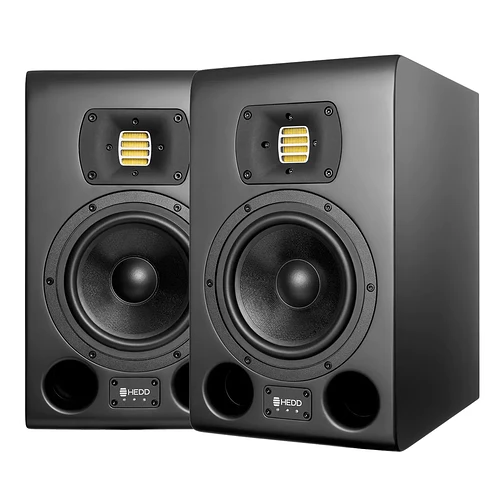
ASHEDDT07PAIR_1024x10241024×1024 64.7 KB
We have seen a tonne of Planer Headphones and IEM’s at very reasonable prices. The difference between the two tech is that Planar is situated on a flat plane and not pleated and folded like the AMT. An AMT driver can move a lot more air with better control and distortion.
Now we see on the market a mass number of AMT drivers and the prices have come down by leaps and bounds. I bought a set for my car for under $100! And they sound amazing.
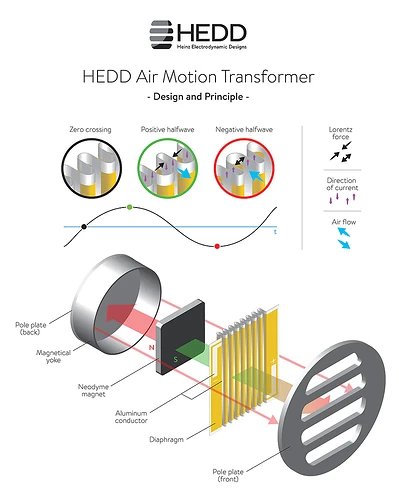
AS_HEDD_Airmotioninfo_1024x1024798×1000 55.6 KB
Car audio has joined the acceptance and application because of the off-axis dispersion is truly mind blowing and gives a massively wide stage even with a lesser than ideal placement.
It was only a matter of time before we saw a full range AMT squeezed into a IEM shell. Thus Goldplanar GL-AMT16 was born.
There will be more and more I am sure as the sound and technology improves with more affordable options.
I personally have a set of AMT Tweeters in my car and my Adam Audio Studio Monitors and love whey do and how they sound.
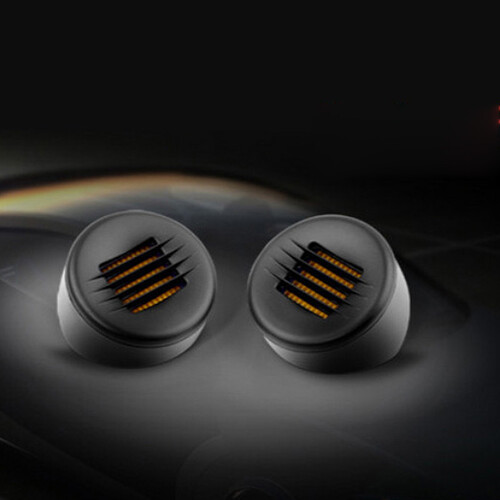
image800×800 60.6 KB
YOU’RE NOT DRIVING THIS ONE OFF YOUR PHONE NOR ARE YOU LISTENING TO IT ON LOW VOLUME. Funny statement because normally AMT tweeters are very linear in their scaling and work great on low volumes and remain incredibly smooth as you dial the volume control. The AMT16 not so much as you will read in the sound part of this review.
SPECS: Goldplanar GL-AMT16
More information can be found here and non-affiliated link: GoldPlanar GL-AMT16 15.5 mm Full-range Air Motion Transformer In-Ear Earphones – Linsoul Audio
Single Driver Configuration consisting of 1 15.5mm Full Range AMT Driver
Anodized Aluminum alloy shell
5 Interchangeable nozzles with ABSOLUTELY NO INFORMATION IN THE GIANT BOOK OF LITERATURE about what they do.
Detachable 0.78 2 Pin Modular cable 3.5 2.5 and 4.4 ends included. It’s a 8 Core cable with 6x 6N Single Crystal Copper and 2 Cores of silver plated Gold Foil.
Frequency response is rated at 15Hz-50KHz.
Impedance is 16 ohms.
Sensitivity of 102db
Weight is 7g ea without cable.
PRE-SOUND IMPRESSIONS - HOW DID I GET HERE:
Well Before I can get into how this sounded, I needed to go through the process of listening to each of the five available nozzles that you can swap on the GL-AMT16.
How much do I love nozzles just about as much as I love tuning switches, I wish this trend would be over sooner than later and manufacturers get back to a tuning that is not only appealing to most but with some reasonable thought and processes going into it.
Now with being said my process of listening to this I am I started off with the default nozzles which are the narrowest bore now I should mention the difference between these nozzles in some companies with different IEM’s they put different tuning sponges or different tuning filters on the nozzle and in the nozzle to make the changes. With the gold plan ARD GL-AMT16 they’ve done something slightly different and in this case what they’ve done is they’ve changed the internal Diane diameter of the boar and what that does is affect the high frequency spectrum quite a lot as you will see from this graph and that changes the overall tuning quite a bit now in the graphs it doesn’t show that the base has changed very much but in reality when you listen to it and what our little brains do is because if we have less of the high frequencies we sound like we have more bass and I’ll get more into the tuning in a bit but let’s just talk about what the nozzles did for me and where I ended up.

1_21_479f3cf8-a161-4010-a034-b7f080e620991000×1000 40.8 KB
So to start off I use the stock tuning which is the 5.5 millimeter outside bore with an internal diameter of 2.7 millimeters so right off the bat my impression of this particular nozzle and in this case I was still using a my favorite JVC FX-10 spiral dots that I love and my first impressions were that this was a pretty smooth tuning but the extension an the upper mid sounded a bit muted also there was a sharpness A sibling 's to the vocals with this particular nozzle.
And then I went to the opposite extreme I went to the six millimeter outside diameter with the internal bore of 4.4 millimeters now with this nozzle I also thought that the vocals sounded a bit thin and forward space was pretty light making instruments like guitar sound Finn with not enough note weight to them.
So, at this point I didn’t really need to go to all five of these nozzles to understand what the internal diameter bore was making the sound signature like, and I worked on more of what I can do to get it closer to what I think is the optimum tuning. After listening for a little while I decided to then graph what all five nozzles were doing at this point to get a better understanding from what I was hearing and see if that translated to the graph, and I could understand that on the graph.
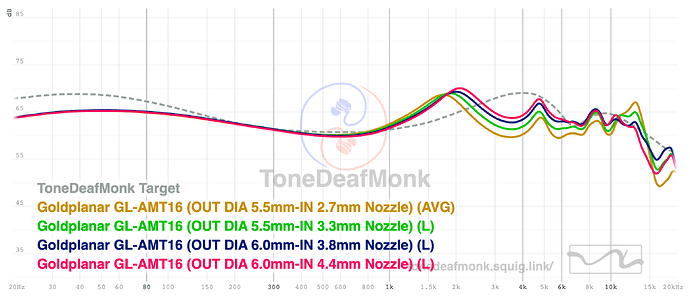
Tuning options2400×1038 247 KB
What came up to my eyes and confirmation to my ears was that there was this peak at two KHz and that was causing some any ear resonances that would make it sound shouty and sibilant and thin.
So at this point I went onto the forums and got some feedback from other people who own this set and their impressions about what they did and one thing that was suggested to me was ditched silicone tips and go with foam tips and that helps quite a bit with the shoutyness.
So that’s what I did I found a set of foam tips that I liked I have no idea what brand they are or where they came from, but they work great for me next, I started playing with nozzle filters so I found that the I liked the most In the end of my nozzle rolling.

20230820_0937391920×1440 289 KB
I found with the extra energy that the 6.0 dash 3.8 millimeter nozzle output and sounded, and that’s where I was going to stick for the remainder of my sound impressions. I like the extra energy up top but if I could just somehow knock down that 2 KHz. pina gain things would be a lot better in my happy zone.
Tips were a wondrous transformation helped quite a bit but there was still something that was off and then I started playing with nozzle filters I ended up starting off with a 400 level mash nozzle moved up to a Tanchjim Oxygen filter, found that was too much of a hit to the upper mids and made vocals too recessed, Next up I then went back down to a cotton filter that’s about a 400 level compared to a mesh one and found that was a happy medium and was close to my desired ideal.
With these changes everything got a lot better got a lot smoother the base became more prominent and started hitting with authority and overall the impressions I was getting about the analogue like sound signature started to really come to shape and I wanted to nurture that more, so that being said let’s play with sources so from there I went to my Geshelli Labs JNOG J2 with the topping A90D amp and then I tried the iFi stack and then I went into my Shandling UP5 and what I found was that the gold planar GL-AMT16 prefers a more warmer source and it really brings out the more analog sound signature on the more analytical sources I found that it really brought out the air the extension and the details but lost out on some of that magic sauce so happy in between was using the Truthear Shio with the CSS stack and that turned out to be a great pairing.
Another interesting Observation was that off of my Hiby R6 Pro2 that there just wasn’t enough juice even at high gain to drive these properly now you’d think that the she row having less juice would be less of a match I’m not sure what it is maybe it’s this DAP and these IEM’s but together it didn’t make the greatest sound combination.
Lastly, CABLES Normally in cables for me I can hear a difference between the differt allow mixes, and I was getting the impression that the stock cable with the copper gold and silver mix which probably not the right mix to have on this IEM. With the tuning nozzle with the more energy, So at this point I switched to a pure copper cable and found that was the magic sauce to put everything together with the less analytical source, the foam ear tips, pure copper cable 6.0 millimeter – 3.8 millimeter bore nozzle 400 level cotton filter on the nozzle I came to euphoria.
So that’s how I came to my final configuration and my listening impressions are based on that.
What I ended up getting was a very analogue sounding old school smooth sound signature great bass extension and the high frequency energy and extension were well balanced in the mix but an incredible amount of detail/air and positioning with a very wide massively open sound-stage that sounds way more like you’re in a concert 100 rows back then you are sitting behind a piece of glass in a studio.

graph(7)2400×1038 213 KB
Pictured in final configuration for sound impressions with Hakugei Peaceful Voice 7N Pure copper cable and some unknown foam Tips.

20230820_0945061920×1440 379 KB
Subjective Part of my Audio Review -
What I Liked:
As all our ears are different shapes & size so what I hear as bright or bass heavy -you might hear as dull and Vise-Versa; just something to be mindful of.
What makes my ears happy as a sound signature is a slightly more aggressive L shape. I love my Bass Sub and Mid Bass slam, love it all actually; and in balanced quantity. With the Bass, I prefer a faster decay the faster the better so as to not bleed into the mids., I am treble sensitive and prefer a slightly darker warmer replay with good treble extension.
I prefer the fast speedy bass of the Beryllium Coated Driver of my Xenns Mangird UP with a Beryllium Coated Driver. My reference is my Softears Twilight and my THOR Mjölinar MKII single DD. And the fabulous 64 Audio U12t that I hold in high regard as well.
Of course, there are exceptions in the market - as I also find the bass of the PENON 10th Anniversary IEM special - has some great mid bass snap as well as some serious sub-bass!
My music Library is widely varied from; Metallica, Great White, Cowboy Junkies, Pink Floyd, Adelle, Melisa Ethridge, Fleetwood Mac, Five for Fighting, Manikin, Poncho Sanchez, Jimmy Smith, Chopin, The Crystal Method just to name a few. When not listening to my test tracks the majority is Jazz or Alternative Rock especially Female Rock. Lorde, Halsey, Alanis Morrisette, Evanescence. All depends on my mood.
My Format has changed with community feedback. So now I will list the music tracks I used & why with my musical impressions of the playback using that track. I hope this will give you some context for my library and give you some context to compare using the same tracks.
THE GOLDPLANAR GL-AMT16 IS UNIQUE, IT DOES NOT SOUND LIKE A PLANER , NOR DYNAMIC DRIVER OR BA SET OR FOR ANYTHING-ELSE I HAVE HEARD.
SOME STANDOUT TRACK IMPRESSIONS:
Let’s Begin:
#1 “Bubbles” by Yosi Horikawa
On this track again it was kind of interesting for the bass you could clearly hear the resonances of the drum skin but what seemed to be missing again was the note weight from like a dynamic driver and the attack and decay though still very good still felt like something was missing.
#4 “99 Luftballons” by Nena
The gold planner GL dash and T16 does vocals amazing this track no exception smooth clear clean articulate and with the correct energy to bring forward female vocals and yet keep a good balance in the track between the base and the high frequency energy.
#5 "Lux AEterna " by Metallica
OVERALL SOUND IMPRESSIONS:
The Goldplanar GL-AMT16 is unique it is unique on the market for now because it is one of the very first air motion transformer IEM’s out there. As more sets like these become more mainstream and the costs come down I think more people will really get to enjoy a truly analog sounding I am.
I have listened to IEM’s that had one component of them whether it be the bass the mid bass or the mids maybe the vocals and even sometimes the high end that had the element of an analog replay old school style sounding but the gold planner AMT-16 does this in a way where it presents an analogue impression on you through and through the entire frequency spectrum and that’s what makes it unique.
This IEM doesn’t sound like I dynamic driver doesn’t sound like a balanced armature set it doesn’t sound like a planer set, nor like any hybrid set using a combination of different drivers. It sounds like an air motion transformer with a big wide huge open stage an incredible extension and the fluidness in the way it presents music.
I love my AMT tweeters in my Adam audio studio monitors it presents in a way with a massively wide stage in fact when I started monitor rolling on my desk, I just had to go back to the Adam audios with AM tweet tweeters because nothing else sounded even remotely close to being as natural without coloration true to the artists intended tuning.
Same as my car audio system the first component I swapped out was the factory Dome tweeters with a set of AMT tweeters and what I found again was what I experienced in all my other dealings with this driver was that it was very linear from very low frequencies or low volumes to higher volumes and it kept its composure and one of the biggest things I noticed in the car probably one of the worst places you could put a sound system is that the stage again opened up a great amount and placement and time alignment was less of a factor. Staging with the AMT tweeters in the side pillars sound like the left side is 6tf outside the car!
What I found strange about the gold planner GL-AM T 16 was that it was different from my experience using this in other applications where I found at low listening volumes it wasn’t a good experience in fact I didn’t enjoy them at all sounded muted and dark and then it wasn’t until you started putting some juice to them where they would really liven up and that’s what kind of threw me off a little bit and in order to get a really good impression of this sound signature you kind of needed to crank it up a bit and give it some juice then they came alive and they sounded natural.
Also when it came to your tips was a bit of a surprise I normally get excellent results with big open board wide nozzles in silicone but in this case this IEM really needs to have foam tips in order to just take out a little bit of the - I don’t know what you would call it maybe glare or sharpness where that 2KHz. bump is affecting the overall tenor and timbe to the vocals while giving a sense of boosted bottom end.
Bass on this one it is nicely weighted but it’s still missing some of that snap and attack in the mid base area that is more tuned toward my preference.
The mids and the vocals of the gold planer GL-AMT16 are spot on male and female with my final tuning and configuration I found mids are very neutral - balanced in the mix upper mid in my journey I feel we’re missing some of that energy in four to 5K area I still wish there was a bit more there and not so scooped out.
For the treble you couldn’t ask for anything nicer very clean very crisp and effortless as well as very articulate and resolving set. The GL-AMT16 is also plays very honestly if you have a poor recording, you hear everything the pops the squeals the noise in the recording you can completely tell if this was a vinyl rip and that just says a lot about how resolving this IEM is.
I think the only hits against this set is for me wishing again more of that mid Bay snap and attack and I found sometimes vocals can sound a bit recessed and thick without tracks with more high frequency energy.
The stage you can easily describe this IAM as having a very wide-open stage definitely more attuned to a concert sounding versus a studio recording I still found that the headspace is all very still intimate. I didn’t find a great amount of death credit card project nor height. I would not describe this I am stage presentation as being very 3D at all.
Conclusion:
Overall if you were willing to take a chance on this set you would get probably the most analogue sounding experiences currently on the market and you would also need to spend some time as well like I did with this set to bring out its best definitely tip rolling cable rolling source rolling are all going to be a must as I would expect you would do nothing less for a set that cost this much money.
Owning this set you will get something unique something other technologies don’t quite bring to the table and for that I’m not sure if the gold planer GL-AMT16 is so unique because of its tuning or is it unique because of its technology the uniqueness of its sound may be determined when more sets come out onto the market and we will get a greater sense of their characteristics when crammed into an IEM shell.
As it is for now, I am humbly thankful for experiencing this set and have enjoyed my time quite a lot. I think it’s one that would be great in your collection if you’re looking for this kind of sound signature and uniqueness. If you think you would enjoy the way the Goldplanar GL-AMT16 have such unique analog sound and have an extra $1499 to spend this is one you may want to consider!
Thank you for taking the time to read my review.
My Video review is here:
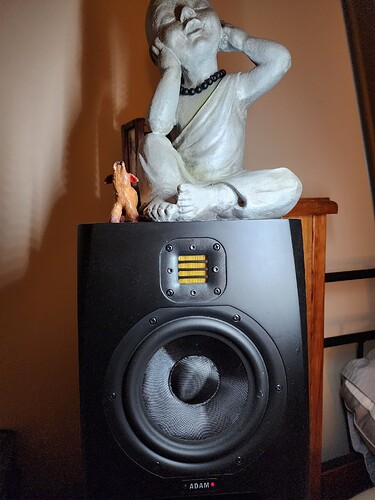
20230812_1953551920×2560 416 KB
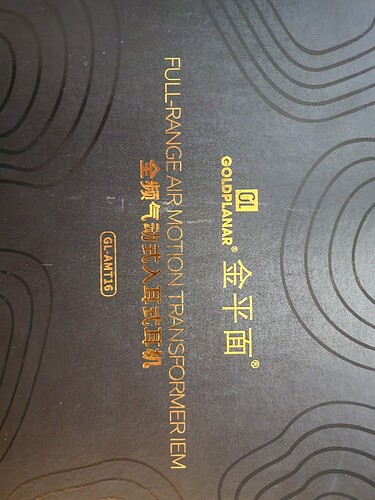
20230814_2027551920×2560 313 KB
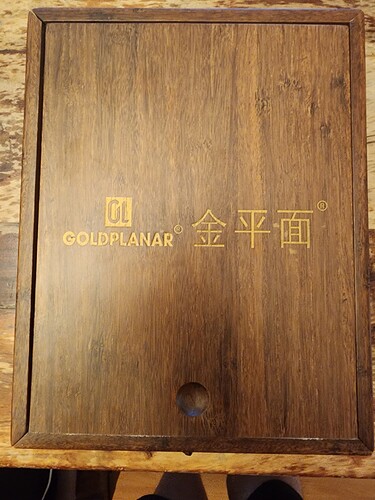
20230814_2028161920×2560 364 KB
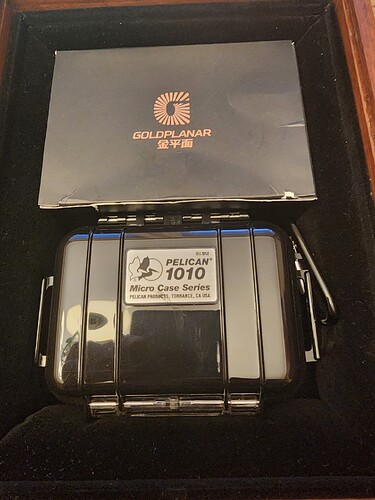
20230814_2028461920×2560 352 KB
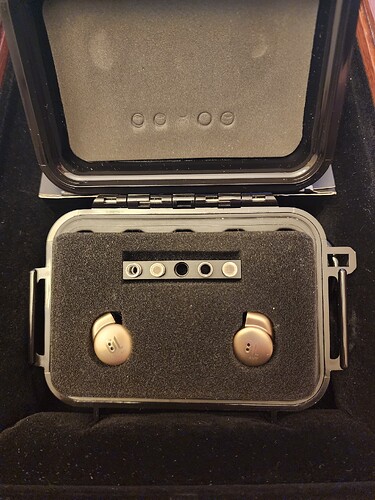
20230814_2029071920×2560 543 KB
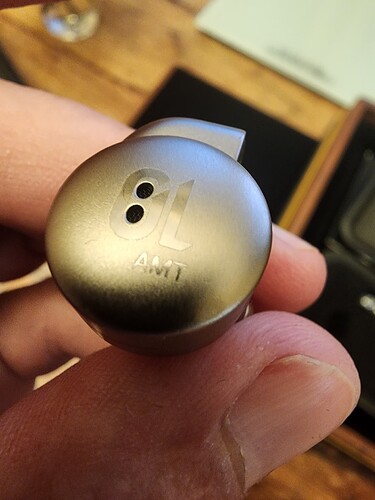
10000119731920×2560 240 KB

20230820_0935581920×1440 326 KB

Title1200×628 128 KB
GOLDPLANAR GL-AMT16 AUG 21 2023

Screenshot 2023-08-19 at 11-11-21 2741.84C$ Goldplanar Gl-amt16 Full-range Pneumatic In-ear Headphones N52 Neodymium Magnetic High End Hifi Headphones - Home Theater Amplifiers - AliExpress509×509 242 KB
This one was so graciously loaned from a fellow audiophile code name Dennis and my many thanks for the opportunity to listen to these unique IEM’S
THIS IS A NEW USE OF A 40YR OLD DREAM

The Goldplanar GL-AMT16 is a single driver IEM utilizing a 15.5mm Air Motion Transformer
This technology was invented by Dr. Oskar Heil in the 70’s
Now let’s get into it: The Techy Stuff
I am going to be spending a bit of time explaining what a AMT is:
An AMT is a form of electrostatic driver a dipole meaning sound is produced on both sides of the driver.
Essentially there is the diaphragm membrane up front there are powerful magnets in the back and there’s a dampening material in the centre to absorb all the unwanted rear waves.
Where a conventional dynamic driver has a voice coil that pushes the cone around the edge, a AMT has its motor bonded onto its surface.

How it works900×381 42.9 KB
The AMT diaphragm is made up of a layer of Kapton - a type of polyimide film and a layer of aluminum bonded to it for the electrical signal to be passed through it.

Substrait1500×1100 457 KB
The Diaphragm is actually, folded in a way with gaps between the folds.
When signal is passed along the circuit in opposing directions it causes the diaphragm to compress and expand the fold causing the air to be squeezed in and out like a bellow.

Folded Motion1297×418 119 KB
There is a lot of surface area in such a small space and to give you a idea how much this 15.5mm diaphragm is squeezed in there the equivalent surface area in a dynamic driver would be 120mm or roughly 8 times a conventional driver.
Now this is not new technology per say but because of the ultra linear response and quick speed Air Motion Transducers were used primarily in tweeters or upper midrange drivers in combination with conventional dynamic drivers for years in higher end speakers and monitors. The primary reason you didn’t see the tech everywhere in the past was higher cost to manufacture.
In 2020 a company called HEDDphone EX Adam Audio guys started using a full range AMT in their headphones. It has a frequency range of an outstanding 10hz-40khz! Admittingly, they knew the whole headphones were heavy and needed power as well. BUT THE SOUND.

AS_HEDD_heddphoneone_02_1024x10241000×1000 134 KB

ASHEDDT07PAIR_1024x10241024×1024 64.7 KB
We have seen a tonne of Planer Headphones and IEM’s at very reasonable prices. The difference between the two tech is that Planar is situated on a flat plane and not pleated and folded like the AMT. An AMT driver can move a lot more air with better control and distortion.
Now we see on the market a mass number of AMT drivers and the prices have come down by leaps and bounds. I bought a set for my car for under $100! And they sound amazing.

AS_HEDD_Airmotioninfo_1024x1024798×1000 55.6 KB
Car audio has joined the acceptance and application because of the off-axis dispersion is truly mind blowing and gives a massively wide stage even with a lesser than ideal placement.
It was only a matter of time before we saw a full range AMT squeezed into a IEM shell. Thus Goldplanar GL-AMT16 was born.
There will be more and more I am sure as the sound and technology improves with more affordable options.
I personally have a set of AMT Tweeters in my car and my Adam Audio Studio Monitors and love whey do and how they sound.

image800×800 60.6 KB
YOU’RE NOT DRIVING THIS ONE OFF YOUR PHONE NOR ARE YOU LISTENING TO IT ON LOW VOLUME. Funny statement because normally AMT tweeters are very linear in their scaling and work great on low volumes and remain incredibly smooth as you dial the volume control. The AMT16 not so much as you will read in the sound part of this review.
SPECS: Goldplanar GL-AMT16
More information can be found here and non-affiliated link: GoldPlanar GL-AMT16 15.5 mm Full-range Air Motion Transformer In-Ear Earphones – Linsoul Audio
Single Driver Configuration consisting of 1 15.5mm Full Range AMT Driver
Anodized Aluminum alloy shell
5 Interchangeable nozzles with ABSOLUTELY NO INFORMATION IN THE GIANT BOOK OF LITERATURE about what they do.
Detachable 0.78 2 Pin Modular cable 3.5 2.5 and 4.4 ends included. It’s a 8 Core cable with 6x 6N Single Crystal Copper and 2 Cores of silver plated Gold Foil.
Frequency response is rated at 15Hz-50KHz.
Impedance is 16 ohms.
Sensitivity of 102db
Weight is 7g ea without cable.
PRE-SOUND IMPRESSIONS - HOW DID I GET HERE:
Well Before I can get into how this sounded, I needed to go through the process of listening to each of the five available nozzles that you can swap on the GL-AMT16.
How much do I love nozzles just about as much as I love tuning switches, I wish this trend would be over sooner than later and manufacturers get back to a tuning that is not only appealing to most but with some reasonable thought and processes going into it.
Now with being said my process of listening to this I am I started off with the default nozzles which are the narrowest bore now I should mention the difference between these nozzles in some companies with different IEM’s they put different tuning sponges or different tuning filters on the nozzle and in the nozzle to make the changes. With the gold plan ARD GL-AMT16 they’ve done something slightly different and in this case what they’ve done is they’ve changed the internal Diane diameter of the boar and what that does is affect the high frequency spectrum quite a lot as you will see from this graph and that changes the overall tuning quite a bit now in the graphs it doesn’t show that the base has changed very much but in reality when you listen to it and what our little brains do is because if we have less of the high frequencies we sound like we have more bass and I’ll get more into the tuning in a bit but let’s just talk about what the nozzles did for me and where I ended up.

1_21_479f3cf8-a161-4010-a034-b7f080e620991000×1000 40.8 KB
So to start off I use the stock tuning which is the 5.5 millimeter outside bore with an internal diameter of 2.7 millimeters so right off the bat my impression of this particular nozzle and in this case I was still using a my favorite JVC FX-10 spiral dots that I love and my first impressions were that this was a pretty smooth tuning but the extension an the upper mid sounded a bit muted also there was a sharpness A sibling 's to the vocals with this particular nozzle.
And then I went to the opposite extreme I went to the six millimeter outside diameter with the internal bore of 4.4 millimeters now with this nozzle I also thought that the vocals sounded a bit thin and forward space was pretty light making instruments like guitar sound Finn with not enough note weight to them.
So, at this point I didn’t really need to go to all five of these nozzles to understand what the internal diameter bore was making the sound signature like, and I worked on more of what I can do to get it closer to what I think is the optimum tuning. After listening for a little while I decided to then graph what all five nozzles were doing at this point to get a better understanding from what I was hearing and see if that translated to the graph, and I could understand that on the graph.

Tuning options2400×1038 247 KB
What came up to my eyes and confirmation to my ears was that there was this peak at two KHz and that was causing some any ear resonances that would make it sound shouty and sibilant and thin.
So at this point I went onto the forums and got some feedback from other people who own this set and their impressions about what they did and one thing that was suggested to me was ditched silicone tips and go with foam tips and that helps quite a bit with the shoutyness.
So that’s what I did I found a set of foam tips that I liked I have no idea what brand they are or where they came from, but they work great for me next, I started playing with nozzle filters so I found that the I liked the most In the end of my nozzle rolling.

20230820_0937391920×1440 289 KB
I found with the extra energy that the 6.0 dash 3.8 millimeter nozzle output and sounded, and that’s where I was going to stick for the remainder of my sound impressions. I like the extra energy up top but if I could just somehow knock down that 2 KHz. pina gain things would be a lot better in my happy zone.
Tips were a wondrous transformation helped quite a bit but there was still something that was off and then I started playing with nozzle filters I ended up starting off with a 400 level mash nozzle moved up to a Tanchjim Oxygen filter, found that was too much of a hit to the upper mids and made vocals too recessed, Next up I then went back down to a cotton filter that’s about a 400 level compared to a mesh one and found that was a happy medium and was close to my desired ideal.
With these changes everything got a lot better got a lot smoother the base became more prominent and started hitting with authority and overall the impressions I was getting about the analogue like sound signature started to really come to shape and I wanted to nurture that more, so that being said let’s play with sources so from there I went to my Geshelli Labs JNOG J2 with the topping A90D amp and then I tried the iFi stack and then I went into my Shandling UP5 and what I found was that the gold planar GL-AMT16 prefers a more warmer source and it really brings out the more analog sound signature on the more analytical sources I found that it really brought out the air the extension and the details but lost out on some of that magic sauce so happy in between was using the Truthear Shio with the CSS stack and that turned out to be a great pairing.
Another interesting Observation was that off of my Hiby R6 Pro2 that there just wasn’t enough juice even at high gain to drive these properly now you’d think that the she row having less juice would be less of a match I’m not sure what it is maybe it’s this DAP and these IEM’s but together it didn’t make the greatest sound combination.
Lastly, CABLES Normally in cables for me I can hear a difference between the differt allow mixes, and I was getting the impression that the stock cable with the copper gold and silver mix which probably not the right mix to have on this IEM. With the tuning nozzle with the more energy, So at this point I switched to a pure copper cable and found that was the magic sauce to put everything together with the less analytical source, the foam ear tips, pure copper cable 6.0 millimeter – 3.8 millimeter bore nozzle 400 level cotton filter on the nozzle I came to euphoria.
So that’s how I came to my final configuration and my listening impressions are based on that.
What I ended up getting was a very analogue sounding old school smooth sound signature great bass extension and the high frequency energy and extension were well balanced in the mix but an incredible amount of detail/air and positioning with a very wide massively open sound-stage that sounds way more like you’re in a concert 100 rows back then you are sitting behind a piece of glass in a studio.

graph(7)2400×1038 213 KB
Pictured in final configuration for sound impressions with Hakugei Peaceful Voice 7N Pure copper cable and some unknown foam Tips.

20230820_0945061920×1440 379 KB
Subjective Part of my Audio Review -
What I Liked:
- Very Analogue presentation through all of the entire frequency spectrum
- Not like anything else currently on the market
- Unboxing Experience second to NONE
- Build quality and fitment should work for most people.
- AMT uniqueness translates into a wide open stage
- Natural way of replaying the music without effort and distortion
- NOWHERE IN THE LITERATURE DOES IT EXPLAIN WHAT SOUND EFFECTS THE DIFFERENT TUNING NOZZLES DO TO THE TUNING. TRIAL AND ERROR AND NOT ACCEPTABLE.
- Mid Bass attack may not be for some as it was done in a way to be present to enhance rather than be fully present in the mix
- Packaging was overly done to my tastes and I found a bitt excessive even on a set costing $1499 Packaging clocks in at 3.2KG over TEN pounds!
- The 2KHz peak in all tunings adds too much of a forwardness and resonances that needs to be addressed a little bit with a tuning filter in order to bring it down to a more natural level in my opinion.
As all our ears are different shapes & size so what I hear as bright or bass heavy -you might hear as dull and Vise-Versa; just something to be mindful of.
What makes my ears happy as a sound signature is a slightly more aggressive L shape. I love my Bass Sub and Mid Bass slam, love it all actually; and in balanced quantity. With the Bass, I prefer a faster decay the faster the better so as to not bleed into the mids., I am treble sensitive and prefer a slightly darker warmer replay with good treble extension.
I prefer the fast speedy bass of the Beryllium Coated Driver of my Xenns Mangird UP with a Beryllium Coated Driver. My reference is my Softears Twilight and my THOR Mjölinar MKII single DD. And the fabulous 64 Audio U12t that I hold in high regard as well.
Of course, there are exceptions in the market - as I also find the bass of the PENON 10th Anniversary IEM special - has some great mid bass snap as well as some serious sub-bass!
My music Library is widely varied from; Metallica, Great White, Cowboy Junkies, Pink Floyd, Adelle, Melisa Ethridge, Fleetwood Mac, Five for Fighting, Manikin, Poncho Sanchez, Jimmy Smith, Chopin, The Crystal Method just to name a few. When not listening to my test tracks the majority is Jazz or Alternative Rock especially Female Rock. Lorde, Halsey, Alanis Morrisette, Evanescence. All depends on my mood.
My Format has changed with community feedback. So now I will list the music tracks I used & why with my musical impressions of the playback using that track. I hope this will give you some context for my library and give you some context to compare using the same tracks.
THE GOLDPLANAR GL-AMT16 IS UNIQUE, IT DOES NOT SOUND LIKE A PLANER , NOR DYNAMIC DRIVER OR BA SET OR FOR ANYTHING-ELSE I HAVE HEARD.
SOME STANDOUT TRACK IMPRESSIONS:
Let’s Begin:
#1 “Bubbles” by Yosi Horikawa
- I found the sense of space the width the depth and the height all excellent done it sounded like it was done in a huge room and the mikes were far and closely spaced to get the effect that being said was it the most natural sounding and the best I’ve heard no I would definitely give that to the Softears Twilight it seemed to also be missing quite a bit of the note weight from the different balls he couldn’t tell that one was a ping pong ball and one was a basketball where on other IEM’s that had more base weight you could clearly hear and feel the difference.
- Very nice base texture on this track with an absolutely incredible extension and sense of air vocals we’re perfect the stage was wide but still fit entirely into your headspace I was getting a good sense of the staging at this point.
On this track again it was kind of interesting for the bass you could clearly hear the resonances of the drum skin but what seemed to be missing again was the note weight from like a dynamic driver and the attack and decay though still very good still felt like something was missing.
#4 “99 Luftballons” by Nena
The gold planner GL dash and T16 does vocals amazing this track no exception smooth clear clean articulate and with the correct energy to bring forward female vocals and yet keep a good balance in the track between the base and the high frequency energy.
#5 "Lux AEterna " by Metallica
- The speed of bass was well presented the what I found was that I was missing the snap that you would get from my dynamic driver or a BA transducer I thought it sounded very analog sounding again but I was kind of missing that extra energy to give it more attack and thus more excitement into this track.
- Such an analog sound. The piano was absolutely bang on vocals were perfect you could hear her actual lips coming together a few times when she is singing such a cool experience and a rare one at that to hear that kind of level of detail was a real treat.
- Track what came to mind was that the presentation was a very organic smooth and wonderful replay I wasn’t listening to any gear at this point I was simply just enjoying the music.
- OK so how did the GL-MT16 do on an orchestral piece well it had a wonderful extension, and the dynamics were great the flute and all the instrumental was done so nicely there was just a hint of warmth maybe that was just the analog sound coming through but whatever it was wonderful.
- The opening of the bells in the clock will put a huge grin on your face. The smooth treble was such a nice presentation and Rodgers vocals had weight and a husk to him that sounded very natural.
- A perfect example on this unique analog presentation the gold planner did this with such a uniqueness that I haven’t heard before what a treat.
- On this track there was some very nice base hits and the weight was great not the fastest but a very nice punchy low end there was zero base bleed outstanding male vocals.
- An amazing ton of high frequency energy and all done so nicely excellent separation sparkles no harshness or sibilance was very cool
- Throwing some EDM here to actually figure out how the bass was going to do and on this track I thought the base was very organic again not very speedy but nicely weighted with an old school analog thump would this be my first choice for this kind of genre probably not but I will tell you one thing you can probably go pretty loud and listen to it for many hours that was a given.
- so I’m trying to listen to some male vocals and the guitar which sounded very nice the sting’s voice is a very smooth melody again I’m -going to use that analog sound didn’t sound like he was in a studio it sounded more of a bigger presentation and that’s kind of unlike most replays I have heard from this song on other IEM
- Very organic sounding vocals so smooth.
- On this track the Bass on the guitar was missing a lot of that mid bass to make it sound acoustically correct the vocals were amazing but the overall presentation just seemed to be lackluster without that sharpness that I came to expect and maybe that was kind of the analog tuning of this set, but it had me wanting for more.
- Well, if you’ve ever listened to this track with Jennifer Warnes’s voice it is an exceptionally well recorded track here you can hear great height excellent details amazing high frequency extension the drum hits we’re a bit weightier and punchier that was a bit of a surprise from the previous tracks.
- How did jazz do well I got to tell you that the little triangle instrument sound at the very beginning sounded amazingly real. The strings are also very good, but the base was light overall the whole presentation was lively and fun. Would I use the gold planner GL-AMT16 for my first choice listening to jazz music no I would probably say not there’s just not enough wait too the bass guitar and the drums to give it a realistic replay but the presentation and the space that it presents in is also very appealing.
- This track is a perfect example of what the AMT 16 does best very analog you hear the noises the pops then the Super incredible vocals you hear it all very detailed done in a way that again I found it was very special.
- On this track the trumpets sounded fabulous but again they’re Achilles heel of the Goldplanar GL-AMT16 is of the bottom end where Poncho’s drums just didn’t sound like they had the Poncho punch to them
OVERALL SOUND IMPRESSIONS:
The Goldplanar GL-AMT16 is unique it is unique on the market for now because it is one of the very first air motion transformer IEM’s out there. As more sets like these become more mainstream and the costs come down I think more people will really get to enjoy a truly analog sounding I am.
I have listened to IEM’s that had one component of them whether it be the bass the mid bass or the mids maybe the vocals and even sometimes the high end that had the element of an analog replay old school style sounding but the gold planner AMT-16 does this in a way where it presents an analogue impression on you through and through the entire frequency spectrum and that’s what makes it unique.
This IEM doesn’t sound like I dynamic driver doesn’t sound like a balanced armature set it doesn’t sound like a planer set, nor like any hybrid set using a combination of different drivers. It sounds like an air motion transformer with a big wide huge open stage an incredible extension and the fluidness in the way it presents music.
I love my AMT tweeters in my Adam audio studio monitors it presents in a way with a massively wide stage in fact when I started monitor rolling on my desk, I just had to go back to the Adam audios with AM tweet tweeters because nothing else sounded even remotely close to being as natural without coloration true to the artists intended tuning.
Same as my car audio system the first component I swapped out was the factory Dome tweeters with a set of AMT tweeters and what I found again was what I experienced in all my other dealings with this driver was that it was very linear from very low frequencies or low volumes to higher volumes and it kept its composure and one of the biggest things I noticed in the car probably one of the worst places you could put a sound system is that the stage again opened up a great amount and placement and time alignment was less of a factor. Staging with the AMT tweeters in the side pillars sound like the left side is 6tf outside the car!
What I found strange about the gold planner GL-AM T 16 was that it was different from my experience using this in other applications where I found at low listening volumes it wasn’t a good experience in fact I didn’t enjoy them at all sounded muted and dark and then it wasn’t until you started putting some juice to them where they would really liven up and that’s what kind of threw me off a little bit and in order to get a really good impression of this sound signature you kind of needed to crank it up a bit and give it some juice then they came alive and they sounded natural.
Also when it came to your tips was a bit of a surprise I normally get excellent results with big open board wide nozzles in silicone but in this case this IEM really needs to have foam tips in order to just take out a little bit of the - I don’t know what you would call it maybe glare or sharpness where that 2KHz. bump is affecting the overall tenor and timbe to the vocals while giving a sense of boosted bottom end.
Bass on this one it is nicely weighted but it’s still missing some of that snap and attack in the mid base area that is more tuned toward my preference.
The mids and the vocals of the gold planer GL-AMT16 are spot on male and female with my final tuning and configuration I found mids are very neutral - balanced in the mix upper mid in my journey I feel we’re missing some of that energy in four to 5K area I still wish there was a bit more there and not so scooped out.
For the treble you couldn’t ask for anything nicer very clean very crisp and effortless as well as very articulate and resolving set. The GL-AMT16 is also plays very honestly if you have a poor recording, you hear everything the pops the squeals the noise in the recording you can completely tell if this was a vinyl rip and that just says a lot about how resolving this IEM is.
I think the only hits against this set is for me wishing again more of that mid Bay snap and attack and I found sometimes vocals can sound a bit recessed and thick without tracks with more high frequency energy.
The stage you can easily describe this IAM as having a very wide-open stage definitely more attuned to a concert sounding versus a studio recording I still found that the headspace is all very still intimate. I didn’t find a great amount of death credit card project nor height. I would not describe this I am stage presentation as being very 3D at all.
Conclusion:
Overall if you were willing to take a chance on this set you would get probably the most analogue sounding experiences currently on the market and you would also need to spend some time as well like I did with this set to bring out its best definitely tip rolling cable rolling source rolling are all going to be a must as I would expect you would do nothing less for a set that cost this much money.
Owning this set you will get something unique something other technologies don’t quite bring to the table and for that I’m not sure if the gold planer GL-AMT16 is so unique because of its tuning or is it unique because of its technology the uniqueness of its sound may be determined when more sets come out onto the market and we will get a greater sense of their characteristics when crammed into an IEM shell.
As it is for now, I am humbly thankful for experiencing this set and have enjoyed my time quite a lot. I think it’s one that would be great in your collection if you’re looking for this kind of sound signature and uniqueness. If you think you would enjoy the way the Goldplanar GL-AMT16 have such unique analog sound and have an extra $1499 to spend this is one you may want to consider!
Thank you for taking the time to read my review.
My Video review is here:

20230812_1953551920×2560 416 KB

20230814_2027551920×2560 313 KB

20230814_2028161920×2560 364 KB

20230814_2028461920×2560 352 KB

20230814_2029071920×2560 543 KB

10000119731920×2560 240 KB

20230820_0935581920×1440 326 KB
Last edited:
ToneDeafMonk
If it was not for price would be a 4.5
o0genesis0o
What a cool and rare IEM you have there. Nice review 

